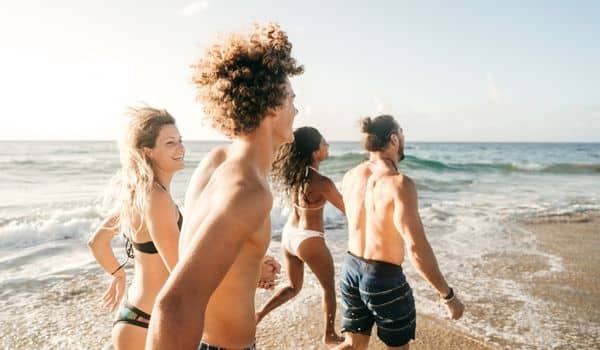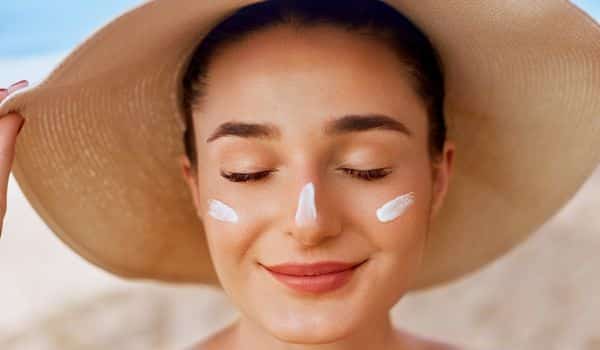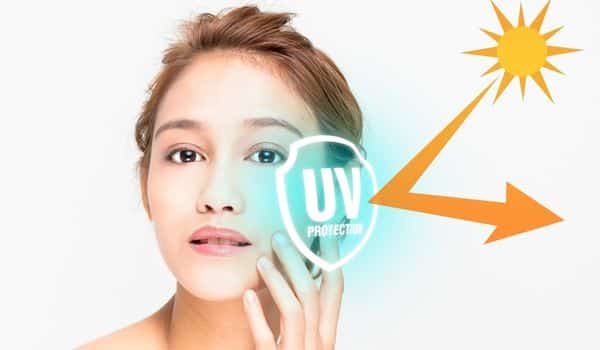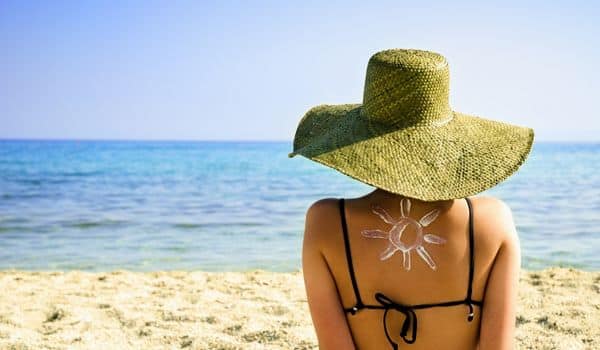Skin cancer is the most common form of cancer in New Zealand and everybody is at risk and should take precautions. It is never too early or late to start improving your sunbathing habits to help lower your risk of skin cancer. Most skin cancers are preventable, so effective sun protection could potentially save your life.
Dr Mark Gittos performs complex Skin Cancer Removals and reconstructions and is a Specialist Plastic Surgeon based in Auckland, with clinics around New Zealand. If you need to remove a complex skin cancer – contact one of the clinics.
Slip, Slop, Slap, Seek & Slide
The Cancer Council’s recommends 5 steps of effective sun protection:
- Slip on sun-protective clothing
- Slop on SPF 30+ or higher, broad-spectrum and water-resistant sunscreen
- Slap on a hat
- Seek out a shady spot
- Slide on sunglasses
Kiwis and Sunshine – what you need to remember

There is no doubt about it – sunlight is essential for our overall health. However, the sun is not an ally when it comes to skin health or the ageing process. Excessive sun exposure is one of the known factors that can cause premature skin ageing. With sun exposure involved in the development of Melasma (pigmentation differences across the face), and higher skin cancer rates, what are the Skin Cancer Sun Protection Tips that you need to know about?
How to Avoid Sun Exposure Damaging Your Skin
Don’t make the mistake of getting complacent about sun exposure, thinking sunscreen will keep you safe. Actually, it’s cumulative sun exposure that has the greatest impact – as well as how well you protect yourself from the sun on any given day – that’s important in preventing sun spots, premature ageing and skin cancers such as SCC skin cancer, BCC skin cancer or melanoma.
So prevention is a multi-faceted endeavour – limiting exposure, covering up, wearing the right types of protection AND minimising your time in the sun.
Are Kiwis Good at Sun Protection? Here is the truth about protective clothing and best sunscreens for your skin.
Slip, slop and slap are good behaviours, but only if you’re diligent. Slip on a shirt, Slop on Suncreen and Slap on a hat. If you don’t treat sun protection with a religious-like zeal, you are likely NOT doing your skin any favours.
Sun Protection Tips & Sunscreens
How to protect your SKIN from sun damage or premature ageing
Being in the sun not only increases your risks of developing skin cancer, but it also ages your skin rapidly. Find out about the Best Sunscreens for sun protection – to help you keep your skin looking younger and even-toned for longer.
Why you need good Sunscreen:
- The more sun over time, cumulatively, the more your skin will age. If you want to look your best for longer, AVOID the sun as much as you can
- The more sunburns you get, the higher your skin cancer risks (but even ONE serious sunburn increases your chances)
- You often get sun when and where you least expect it – driving to work, for example, or sitting by a window at your office
Sun Protection Basics – The Best Sunscreens

You know you want your skin to look great throughout your life. So how do you make sure you keep the sun’s rays from doing harm?
Sun exposure is responsible to lead to 80 to 90% of the differences in:
- A person’s VISIBLE age versus their biological age
- The appearance differences between an individual and others their age (peers)
- The appearance differences in twins or siblings who did NOT get too much sun (smoking also makes skin ageing rapidly accelerate)
How do you know this is true?
Look at the cleavage of anyone who’s seen a lot of sun and is over the age of 30. Their face might not show the damage, because some makeups offered some protection – but few individuals are as protective of their upper chest as they are of their face and shoulders. Even younger individuals can visibly see sun damage if they get a skin assessment using a Woods lamp or imaging such as the Canfield system.
Sun Protection RULE 1 – Limit Sun Exposure
Awareness is crucial – stay vigilant about your exposure to the sun.
- Be aware that you’re getting sun FAR more than you probably recognise
- Work to actually LIMIT your exposure – all year round
- Wear high-protection shades as sun exposure can also damage vision over time – as well as prematurely age your skin
Sun Protection RULE 2 – Know Your Skin & Skin Products
Keep in mind that even skin that tans easily is still prone to ageing and skin cancer (perhaps not as quickly but even so, you’re definitely NOT risk-free and may even be prone to major pigmentation problems like ‘liver spots,’ ‘sun spots’ and Melasma).
- Know your skin type (perhaps investigate the Fitzpatrick skin tone scale) and what your key risks are in terms of premature ageing
- Remember that certain products AND medications make your skin more vulnerable to sun damage
- Check the labels of everything you ingest AND use on your skin to be sure you understand your sun exposure risks at any given time
Sun Protection RULE 3 – use a High-Quality Sunscreen
Remember your skin is your largest organ – and there’s a lot of it to cover.
- Be sure you use high-quality sunscreen on your ears, feet and other areas you may forget – including HANDS and DECOLLETAGE
- Make sure you read the ingredients on sunblocks and sunscreens before you purchase – some of the best sunscreens include “physical blocks” to prevent sun damage (zinc, for example)
Tips for Being Sun Savvy:

- Find UV protective shelters and check the UV protection rating on EVERYTHING you gear up with over summer
- Slip, slop slap. But don’t let following that advice give you false security about being in the sun. Too much sun exposure is TOO MUCH sun exposure, even if you’re reapplying with some of the best sunscreen available
- Employ thick sun blocking curtains and shades at home, and use car window shading with UV protection
- Wearing a high SPF physical-block sunscreen product maybe your best option – even in winter when you’re driving
- Check out the tinted versions that don’t look gluggy and ask a DERMAL CLINICIAN which ones are less prone to flare up any underlying skin conditions (such as acne)
And remember:
- Not all swimwear or sun protection products are equal – do your homework and/or ask a qualified skin care professional at a Clinic
- A hat won’t help if it’s not broad-rimmed AND the right UV protective fabric
- Same for umbrellas – how much sun is actually getting in?
Staying Protected from the Sun – Is a hat enough?
A hat alone is not sufficient (and sadly, currently not on-trend, but that shouldn’t stop you from wearing one).
You should be also using sunblock while being outdoors. You’ll also want to have a strategy to avoid direct and reflected sunlight as much as possible.
The Dangers of Unprotected Sun Exposure
The removal of sun-damaged skin or skin cancers can not only lead to disfigurement, especially if on the face or ears, but sunburns also put your entire well being at risk. Suffering even one very bad sunburn seriously increases your risks of melanoma development, with over 95% of skin cancers caused by sun exposure.
Even knowing the risks, anyone still not inclined to use sunblock to help protect their delicate skin, especially during the upcoming hotter months, is putting themselves at grave risk.
We’ve all heard the term “UV radiation” and nearly all of us has had a sunburn at some point in our lives. UV Radiation is definitely something that everyone all over the planet should be afraid of, and Kiwis in particular given the high rates of exposure and skin cancer risks.
Skin Cancer Causes: Sun Exposure & UV Rays

UV Radiation is known to be linked with the development of skin cancers. This type of radiation comes from the sun’s rays and is so harmful to our heath that the EPA and the World Health Organization have declared it a skin carcinogen[1].
There are three different types of UV rays.
- UV-A (think “A” for “Ageing” of the skin)
- UV-B (think “B” for burning ability)
- UV-C radiation (likely to be highly ‘carcinogenic’ but blocked by the ozone layer)
So whilst you might THINK getting sun exposure makes your skin look good, it’s doing anything BUT that – especially when you work yourself into a sunburn on racing day.
UVA radiation (the A of which stands for ageing is often how people are instructed to help remember it) – is the radiation type that is responsible for ageing, skin cancer, collagen damage and dreaded wrinkles.
- Unlike UVC, the ozone layer barely absorbs the UVA form of radiation
- So UVA radiation makes up for 95% of the UV radiation that hits the Earth – and does the most harm to your skin – on a day at the races
The more you sit out in the sun with unprotected skin, the more it will start to look dry and wrinkly, discoloured or unevenly coloured (such as hyper-pigmentation or melasma), and even leathery.
UVB radiation (the B of which stands for burning) and makes up the remaining 5% of the UV radiation that hits the Earth’s surface.
- UVB radiation is associated with the sun’s benefits and is responsible for the production of vitamin D in our bodies
- Too much of a good thing can lead to damage to the top layer of your skin which can result in either skin cancers or sunburns or both (and the two are linked)
- The ozone layer filters out UVB rays, but sadly, due to the well-known ozone layer depletion (called the “ozone hole”) over our country, more of these rays have been reaching the Earth, likely leading to the increasing risks for skin cancer and why we have some of the highest skin cancer occurrences (it’s also a behavioural issue because we go out in the sun too often, for too long, and without sunblock or sunscreen protection)
Lastly, UVC radiation is the most harmful of the three radiation types. Luckily this radiation is currently mostly blocked by our ozone layer.
How Can I Best Protect Myself from Sun Damage?

Staying out of the sun is the best way to avoid sun damage. But because most of us are outdoors regularly, including at weddings, carnivals and sporting events, there are simple but necessary steps that we can take to better protect ourselves from UV radiation and the harms it does.
These rules apply to everyone: men, women, children and the elderly. Babies as young as six months old should be wearing sunscreen or physical sun block – and should be covered up with UV protection rated clothing when they are younger.
- Always wear sunscreen
- Avoid all sun exposure in the middle of the day because UV rays are strongest during this time
- Be cautious when you’re driving because you are actually getting far more sun exposure than you might realise
- Wear protective clothing. Try wearing long sleeves and pants and a wide-brimmed hat (perfect for the races)
- Reapply your sunscreen regularly and consider the sun-block products that include ingredients that might better block the sun
What Should I Look for in a Sunscreen?
The data has changed and you’ll need to be more diligent than ever when choosing a great sunblock, sunscreen or UV radiation protection product.
SPF means sun protection factor. The SPF number of a product or brand rating tells you how well the product might protect you from UVB, the burning rays of the sun. Up until just a few years ago, all that mattered was choosing a sunblock with a high SPF which only protects from UVB rays or the rays that burn.
It is now shown, however, that UVA rays also increase your skin cancer risks. While UVA rays don’t cause sunburns they can be just as damaging to your underlying tissues or cellular processes – so it’s best to prevent these from reaching your skin as well. And that means to slip, slop, slap but with more carefully selected sunscreen products.
Broad-Spectrum Sunscreens
You’ll want a broad-spectrum sunscreen product that protects your skin from both UVB and UVA rays.
- Look for ingredients with broad-spectrum protection that include titanium dioxide, zinc oxide, benzophenones (oxybenzone), cinnamates (octylmethyl cinnamate and cinoxate), sulisobenzone, salicylates, avobenzone (Parsol 1789) and ecamsule (Mexoryl SX)
- You want an SPF of 15 or higher at a minimum
To protect from UVA rays you really do need to pay attention to the ingredients. Look for a sunscreen that contains at least one of these ingredients:
- titanium dioxide
- sulisobenzone
- zinc oxide ecamsule
- avobenzone
- oxybenzone
Any of those should work well to protect from UVA Rays.
How Should I Apply Sunscreen or Sun Block
Always apply sunscreen at least 20 to 30 minutes BEFORE you go outdoors or swimming and whenever you will be exposed for 15 minutes or more (or even for a few minutes if you have just had a procedure done or have easily-burning skin). You should also reapply sunscreen at least every two hours while you are outdoors – regardless of what the product says.
Reapply more often if you are swimming or perspiring heavily.
There really is no such thing as ‘all day protection’. In fact, you’ll want to be very diligent about applying it often, and not just if you are swimming or sweating heavily – although if you are, you’ll want to reapply it even more frequently. But don’t count on sunblock alone to protect you – remember the slogan and wear the right protective clothing, a wide-brimmed hat and sunnies, and try to get out of the direct sun (or even reflected sun light) as much as you possibly can.
Be sure to cover all exposed areas and do not forget your ears, lips, and back of your hands. If you have sensitive skin be sure to connect with your Dermal Clinician about selecting a product that is right for you!
Remember also, that some medications and health conditions make your skin extremely sensitive to burning; be sure to let your Dermal Clinician know what your sensitivities might be in terms of being sun-sensitive for whatever reason.
[1] Source: http://www.epa.sa.gov.au/environmental_info/radiation/understanding_radiation/uv_radiation
Further Reading about Skin Cancer
- Skin Cancer Surgery in NZ
- Why get a Skin Cancer Check in Winter?
- Tips of Skin Cancer and Their Cause
Medical References about Sun Exposure and Skin Damage
- Sun exposure and risk of melanoma
- Sun Exposure and Melanoma, Certainties and Weaknesses of the Present Knowledge
- Sun Exposure and Skin Cancer
About Dr Mark Gittos FRACS (Plast) – New Zealand Plastic Surgeon
Practice locations in Herne Bay Auckland, Northland and Bay of Plenty – Kerikeri, Whangarei, New Plymouth & Tauranga
Dr Mark Gittos is a leading Specialist Plastic Surgeon and operates a practice in Herne Bay, Auckland and in the UK. The practice focuses on both surgical and non-surgical procedures, each designed to help restore, improve or change a physical characteristic or problem. The first step in every case is to talk through your personal requirements and explore all the options, before deciding on the most effective solution.
Dr Mark Gittos offers high quality, natural-looking cosmetic surgery results and is highly experienced in Breast, Body and Face Surgery having performed over 4000 Surgeries in the last 26 years. With worldwide expertise Dr Gittos is an expert in breast, face and body surgery for men & women.
Naturally, before any treatment is begun, we will explain clearly the advantages and risk factors; so that you have the information you need to make an informed decision that is best for you. Visit the practice to find out more.

NEXT STEPS
Please NOTE: Dr Gittos only performs surgery on non-smoker patients with a BMI less than 30. To check your BMI please visit the NZ Heart Foundation website. For help giving up smoking before surgery visit the Smoke Free website
Do your Research
- Read the Website and Blogs relevant to your procedure
- Browse our Frequently Asked Questions including how to choose a Surgeon for your procedure
- Download and read the FREE Guides to Surgery
What to Bring to your Plastic Surgeon Consultation
- Bring a friend or relative to help discuss the information and your choices
- Take lots of notes and read the documents provided thoroughly
- Dress in simple clothes as you may need to undress for examination
- Bring your medical referral and any relevant medical documents or test results
Book your Initial Surgery Consultation
- A Referral from your GP or specialist is helpful but NOT essential – you can have a consultation without a GP Referral
- Email us or Call on 09 529 5352 to arrange your surgeon consultation appointment.
- Book a consultation with Dr Gittos by paying the Consultation Fee – $350 incl GST
Traveling for Surgery? – Consider post-surgery luxury recovery in a Hotel with LuxeCare
Please contact us to arrange to book a consultation with our Specialist Plastic Surgeon or to speak with our Patient Care Advisor.
Send an enquiry form today or phone 09 529 5352 during Clinic Hours
